(All information courtesy of the instrument teams.)
![]() Previous IAU Circulars
Previous IAU Circulars
TITLE: GCN/SWIFT NOTICE
NOTICE_DATE: Sun 26 Oct 14 02:38:08 UT
NOTICE_TYPE: Swift-BAT GRB Position
TRIGGER_NUM: 616502, Seg_Num: 0
GRB_RA: 44.080d {+02h 56m 19s} (J2000),
44.300d {+02h 57m 12s} (current),
43.342d {+02h 53m 22s} (1950)
GRB_DEC: +26.960d {+26d 57' 36"} (J2000),
+27.019d {+27d 01' 09"} (current),
+26.759d {+26d 45' 31"} (1950)
GRB_ERROR: 3.00 [arcmin radius, statistical only]
GRB_INTEN: 0 [cnts] Image_Peak=2012 [image_cnts]
TRIGGER_DUR: 64.000 [sec]
TRIGGER_INDEX: 20000 E_range: 15-50 keV
BKG_INTEN: 0 [cnts]
BKG_TIME: 0.00 SOD {00:00:00.00} UT
BKG_DUR: 0 [sec]
GRB_DATE: 16956 TJD; 299 DOY; 14/10/26
GRB_TIME: 9411.29 SOD {02:36:51.29} UT
GRB_PHI: 129.02 [deg]
GRB_THETA: 15.75 [deg]
SOLN_STATUS: 0x13
RATE_SIGNIF: 0.00 [sigma]
IMAGE_SIGNIF: 11.00 [sigma]
MERIT_PARAMS: +1 +0 +0 +6 +1 +0 +0 +0 +94 +0
SUN_POSTN: 210.40d {+14h 01m 37s} -12.37d {-12d 22' 25"}
SUN_DIST: 160.40 [deg] Sun_angle= 11.1 [hr] (West of Sun)
MOON_POSTN: 237.50d {+15h 50m 00s} -16.71d {-16d 42' 26"}
MOON_DIST: 164.01 [deg]
MOON_ILLUM: 5 [%]
GAL_COORDS: 154.53,-28.14 [deg] galactic lon,lat of the burst (or transient)
ECL_COORDS: 49.48, 9.75 [deg] ecliptic lon,lat of the burst (or transient)
COMMENTS: SWIFT-BAT GRB Coordinates.
COMMENTS: This is an image trigger. (The RATE_SIGNIF & BKG_{INTEN, TIME, DUR} are undefined.)
COMMENTS: A point_source was found.
COMMENTS: This does not match any source in the on-board catalog.
COMMENTS: This does not match any source in the ground catalog.
COMMENTS: This is a GRB.
COMMENTS: This trigger occurred at longitude,latitude = 54.12,20.32 [deg].
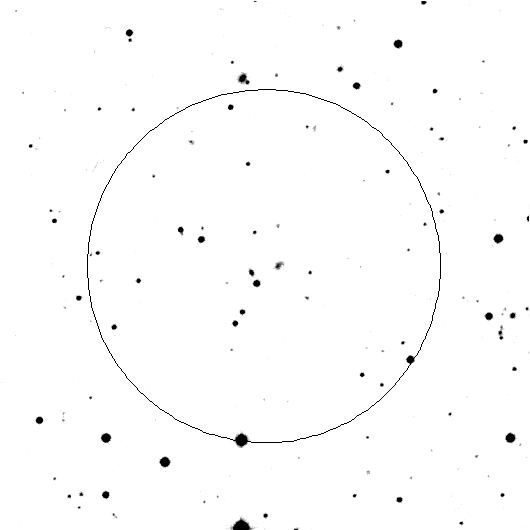
TITLE: GCN/SWIFT NOTICE
NOTICE_DATE: Sun 26 Oct 14 02:40:01 UT
NOTICE_TYPE: Swift-XRT Position
TRIGGER_NUM: 616502, Seg_Num: 0
GRB_RA: 44.0839d {+02h 56m 20.13s} (J2000),
44.3030d {+02h 57m 12.71s} (current),
43.3461d {+02h 53m 23.06s} (1950)
GRB_DEC: +26.9262d {+26d 55' 34.3"} (J2000),
+26.9853d {+26d 59' 07.2"} (current),
+26.7250d {+26d 43' 29.8"} (1950)
GRB_ERROR: 6.1 [arcsec radius, statistical plus systematic, 90% containment]
GRB_INTEN: 1.58e-08 [erg/cm2/sec]
GRB_SIGNIF: 5.09 [sigma]
IMG_START_DATE: 16956 TJD; 299 DOY; 14/10/26
IMG_START_TIME: 9568.29 SOD {02:39:28.29} UT, 157.0 [sec] since BAT Trigger Time
TAM[0-3]: 327.67 237.21 261.58 243.45
AMPLIFIER: 2
WAVEFORM: 134
SUN_POSTN: 210.40d {+14h 01m 37s} -12.37d {-12d 22' 27"}
SUN_DIST: 160.42 [deg] Sun_angle= 11.1 [hr] (West of Sun)
MOON_POSTN: 237.52d {+15h 50m 05s} -16.71d {-16d 42' 34"}
MOON_DIST: 164.02 [deg]
MOON_ILLUM: 5 [%]
GAL_COORDS: 154.55,-28.17 [deg] galactic lon,lat of the burst
ECL_COORDS: 49.48, 9.71 [deg] ecliptic lon,lat of the burst
COMMENTS: SWIFT-XRT Coordinates.
COMMENTS: The XRT position is 2.02 arcmin from the BAT position.
TITLE: GCN/SWIFT NOTICE
NOTICE_DATE: Sun 26 Oct 14 02:40:09 UT
NOTICE_TYPE: Swift-XRT Image
TRIGGER_NUM: 616502, Seg_Num: 0
GRB_RA: 44.0839d {+02h 56m 20.1s} (J2000),
44.3030d {+02h 57m 12.7s} (current),
43.3461d {+02h 53m 23.0s} (1950)
GRB_DEC: +26.9262d {+26d 55' 34.3"} (J2000),
+26.9853d {+26d 59' 07.2"} (current),
+26.7250d {+26d 43' 29.8"} (1950)
GRB_ERROR: 5.8 [arcsec, radius, statistical plus systematic]
GRB_INTEN: 26 [cnts]
IMG_START_DATE: 16956 TJD; 299 DOY; 14/10/26
IMG_START_TIME: 9568.29 SOD {02:39:28.29} UT, 157.0 [sec] since BAT Trigger Time
CENTROID_X: 371.45, raw= 371 [pixels]
CENTROID_Y: 283.55, raw= 284 [pixels]
ROLL: 44.02 [deg]
GAIN: 1
MODE: 2, Short Image mode
WAVEFORM: 134
EXPO_TIME: 0.10 [sec]
GRB_POS_XRT_Y: -33.59
GRB_POS_XRT_Z: 155.94
IMAGE_URL: sw00616502000msxps_rw.img
SUN_POSTN: 210.40d {+14h 01m 37s} -12.37d {-12d 22' 27"}
SUN_DIST: 160.42 [deg] Sun_angle= 11.1 [hr] (West of Sun)
MOON_POSTN: 237.52d {+15h 50m 05s} -16.71d {-16d 42' 35"}
MOON_DIST: 164.02 [deg]
MOON_ILLUM: 5 [%]
GAL_COORDS: 154.55,-28.17 [deg] galactic lon,lat of the burst
ECL_COORDS: 49.48, 9.71 [deg] ecliptic lon,lat of the burst
COMMENTS: SWIFT-XRT Image.

TITLE: GCN/SWIFT NOTICE
NOTICE_DATE: Sun 26 Oct 14 02:40:17 UT
NOTICE_TYPE: Swift-XRT Processed Image
TRIGGER_NUM: 616502, Seg_Num: 0
GRB_RA: 44.0839d {+02h 56m 20.1s} (J2000),
44.3030d {+02h 57m 12.7s} (current),
43.3461d {+02h 53m 23.0s} (1950)
GRB_DEC: +26.9262d {+26d 55' 34.3"} (J2000),
+26.9853d {+26d 59' 07.2"} (current),
+26.7250d {+26d 43' 29.8"} (1950)
GRB_ERROR: 5.8 [arcsec, radius, statistical plus systematic]
GRB_INTEN: 26 [cnts]
IMG_START_DATE: 16956 TJD; 299 DOY; 14/10/26
IMG_START_TIME: 9568.29 SOD {02:39:28.29} UT, 157.0 [sec] since BAT Trigger Time
CENTROID_X: 371.45, raw= 371 [pixels]
CENTROID_Y: 283.55, raw= 284 [pixels]
ROLL: 44.02 [deg]
GAIN: 1
MODE: 2, Short Image mode
WAVEFORM: 134
EXPO_TIME: 0.10 [sec]
GRB_POS_XRT_Y: -33.59
GRB_POS_XRT_Z: 155.94
IMAGE_URL: sw00616502000msxps_rw.img
SUN_POSTN: 210.40d {+14h 01m 37s} -12.37d {-12d 22' 27"}
SUN_DIST: 160.42 [deg] Sun_angle= 11.1 [hr] (West of Sun)
MOON_POSTN: 237.52d {+15h 50m 05s} -16.71d {-16d 42' 36"}
MOON_DIST: 164.02 [deg]
MOON_ILLUM: 5 [%]
GAL_COORDS: 154.55,-28.17 [deg] galactic lon,lat of the burst
ECL_COORDS: 49.48, 9.71 [deg] ecliptic lon,lat of the burst
COMMENTS: SWIFT-XRT Processed Image.

TITLE: GCN/SWIFT NOTICE
NOTICE_DATE: Sun 26 Oct 14 02:41:02 UT
NOTICE_TYPE: Swift-UVOT Source List
TRIGGER_NUM: 616502, Seg_Num: 0
POINT_RA: 44.110d {+02h 56m 26s} (J2000)
POINT_DEC: +26.965d {+26d 57' 55"} (J2000)
POINT_ROLL: 44.014d
IMG_START_DATE: 16956 TJD; 299 DOY; 14/10/26
IMG_START_TIME: 9576.88 SOD {02:39:36.88} UT, 165.6 [sec] since BAT Trigger Time
FILTER: 10, White
BKG_MEAN: 1.200
N_STARS: 20
X_OFFSET: 280 [pixels]
Y_OFFSET: 528 [pixels]
X_MAX: 1239 [pixels]
Y_MAX: 1487 [pixels]
DET_THRESH: 9
PHOTO_THRESH: 4
SL_URL: sw00616502000msufc0165.fits
SUN_POSTN: 210.40d {+14h 01m 37s} -12.37d {-12d 22' 28"}
SUN_DIST: 160.38 [deg] Sun_angle= 11.1 [hr] (West of Sun)
MOON_POSTN: 237.53d {+15h 50m 07s} -16.71d {-16d 42' 39"}
MOON_DIST: 164.01 [deg]
MOON_ILLUM: 5 [%]
GAL_COORDS: 154.55,-28.12 [deg] galactic lon,lat of the pointing direction
ECL_COORDS: 49.51, 9.75 [deg] ecliptic lon,lat of the pointing direction
COMMENTS: SWIFT-UVOT Source List.
TITLE: GCN/SWIFT NOTICE
NOTICE_DATE: Sun 26 Oct 14 02:41:21 UT
NOTICE_TYPE: Swift-UVOT Processed Source List
TRIGGER_NUM: 616502, Seg_Num: 0
POINT_RA: 44.110d {+02h 56m 26s} (J2000)
POINT_DEC: +26.965d {+26d 57' 55"} (J2000)
POINT_ROLL: 44.014d
IMG_START_DATE: 16956 TJD; 299 DOY; 14/10/26
IMG_START_TIME: 9576.88 SOD {02:39:36.88} UT, 165.6 [sec] since BAT Trigger Time
FILTER: 10, White
BKG_MEAN: 1.200
N_STARS: 20
X_OFFSET: 280 [pixels]
Y_OFFSET: 528 [pixels]
X_MAX: 1239 [pixels]
Y_MAX: 1487 [pixels]
DET_THRESH: 9
PHOTO_THRESH: 4
SL_URL: sw00616502000msufc0165.fits
SUN_POSTN: 210.41d {+14h 01m 37s} -12.37d {-12d 22' 28"}
SUN_DIST: 160.38 [deg] Sun_angle= 11.1 [hr] (West of Sun)
MOON_POSTN: 237.53d {+15h 50m 08s} -16.71d {-16d 42' 41"}
MOON_DIST: 164.01 [deg]
MOON_ILLUM: 5 [%]
GAL_COORDS: 154.55,-28.12 [deg] galactic lon,lat of the pointing direction
ECL_COORDS: 49.51, 9.75 [deg] ecliptic lon,lat of the pointing direction
COMMENTS: SWIFT-UVOT Processed Source List.
COMMENTS: All 4 attachments are included.
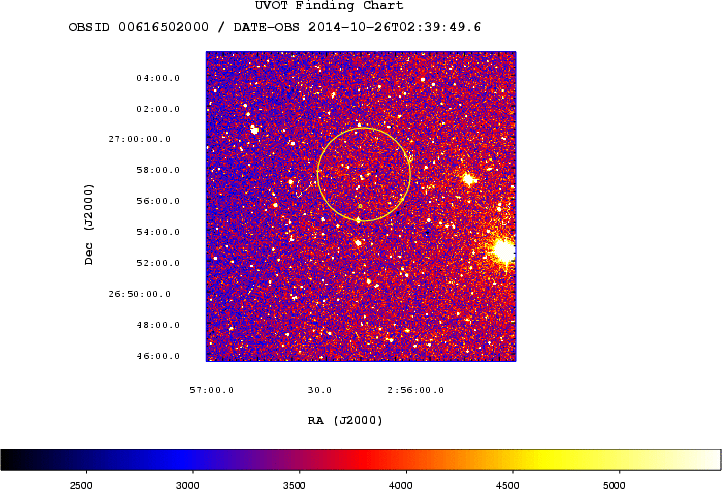
TITLE: GCN/SWIFT NOTICE
NOTICE_DATE: Sun 26 Oct 14 02:42:52 UT
NOTICE_TYPE: Swift-UVOT Image
TRIGGER_NUM: 616502, Seg_Num: 0
POINT_RA: 44.110d {+02h 56m 26s} (J2000)
POINT_DEC: +26.965d {+26d 57' 55"} (J2000)
ROLL: 44.014d
IMG_START_DATE: 16956 TJD; 299 DOY; 14/10/26
IMG_START_TIME: 9576.88 SOD {02:39:36.88} UT, 165.6 [sec] since BAT Trigger Time
FILTER: 10, White
EXPOSURE_ID: 435983989
X_OFFSET: 554 [pixels]
Y_OFFSET: 1085 [pixels]
WIDTH: 160 [pixels]
HEIGHT: 160 [pixels]
X_GRB_POS: 714
Y_GRB_POS: 1245
BINNING_INDEX: 1
IM_URL: sw00616502000msuni0178.fits
SUN_POSTN: 210.41d {+14h 01m 37s} -12.38d {-12d 22' 30"}
SUN_DIST: 160.38 [deg] Sun_angle= 11.1 [hr] (West of Sun)
MOON_POSTN: 237.55d {+15h 50m 11s} -16.71d {-16d 42' 48"}
MOON_DIST: 164.00 [deg]
MOON_ILLUM: 5 [%]
GAL_COORDS: 154.55,-28.12 [deg] galactic lon,lat of the pointing direction
ECL_COORDS: 49.51, 9.75 [deg] ecliptic lon,lat of the pointing direction
COMMENTS: SWIFT-UVOT Image.
COMMENTS: The GRB Position came from the XRT Position Command.
COMMENTS: The image has 2x2 binning (compression).
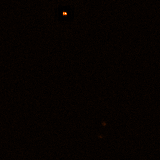
TITLE: GCN/SWIFT NOTICE
NOTICE_DATE: Sun 26 Oct 14 02:43:09 UT
NOTICE_TYPE: Swift-BAT GRB Lightcurve
TRIGGER_NUM: 616502, Seg_Num: 0
GRB_RA: 44.080d {+02h 56m 19s} (J2000),
44.300d {+02h 57m 12s} (current),
43.342d {+02h 53m 22s} (1950)
GRB_DEC: +26.960d {+26d 57' 36"} (J2000),
+27.019d {+27d 01' 09"} (current),
+26.759d {+26d 45' 31"} (1950)
GRB_DATE: 16956 TJD; 299 DOY; 14/10/26
GRB_TIME: 9411.29 SOD {02:36:51.29} UT
TRIGGER_INDEX: 20000
GRB_PHI: 129.02 [deg]
GRB_THETA: 15.75 [deg]
DELTA_TIME: 0.00 [sec]
TRIGGER_DUR: 64.000 [sec]
SOLN_STATUS: 0x13
RATE_SIGNIF: 0.00 [sigma]
IMAGE_SIGNIF: 11.00 [sigma]
LC_URL: sw00616502000msb.lc
SUN_POSTN: 210.41d {+14h 01m 38s} -12.38d {-12d 22' 30"}
SUN_DIST: 160.40 [deg] Sun_angle= 11.1 [hr] (West of Sun)
MOON_POSTN: 237.55d {+15h 50m 12s} -16.71d {-16d 42' 49"}
MOON_DIST: 163.98 [deg]
MOON_ILLUM: 5 [%]
GAL_COORDS: 154.53,-28.14 [deg] galactic lon,lat of the burst (or transient)
ECL_COORDS: 49.48, 9.75 [deg] ecliptic lon,lat of the burst (or transient)
COMMENTS: SWIFT-BAT GRB Lightcurve.
COMMENTS:
COMMENTS: The next comments were copied from the BAT_POS Notice:
COMMENTS: This is an image trigger.
COMMENTS: A point_source was found.
COMMENTS: This does not match any source in the on-board catalog.
COMMENTS: This does not match any source in the ground catalog.
COMMENTS: This is a GRB.
COMMENTS: This trigger occurred at longitude,latitude = 54.12,20.32 [deg].
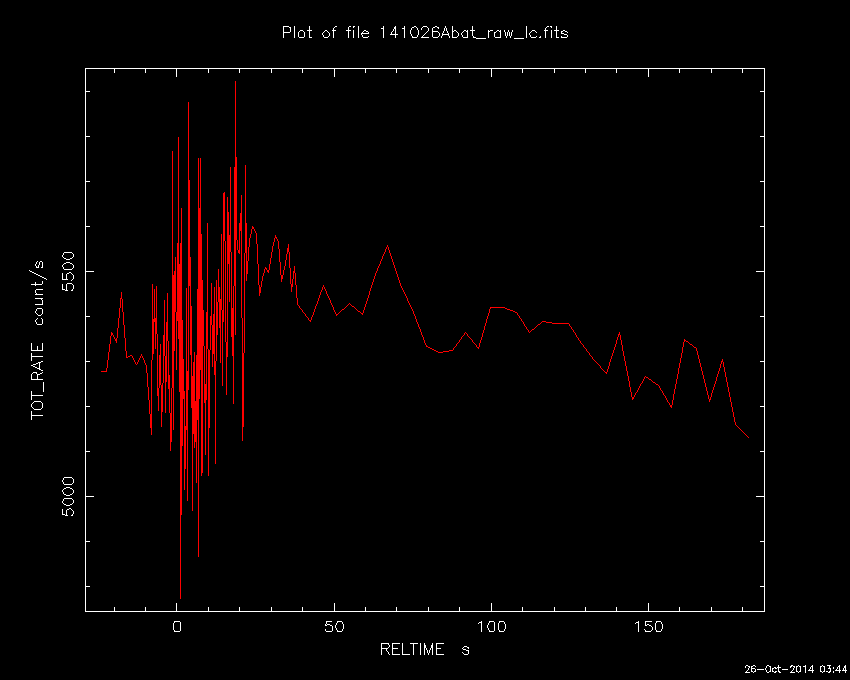
TITLE: GCN/SWIFT NOTICE
NOTICE_DATE: Sun 26 Oct 14 02:43:34 UT
NOTICE_TYPE: Swift-UVOT Processed Image
TRIGGER_NUM: 616502, Seg_Num: 0
POINT_RA: 44.110d {+02h 56m 26s} (J2000)
POINT_DEC: +26.965d {+26d 57' 55"} (J2000)
ROLL: 44.014d
IMG_START_DATE: 16956 TJD; 299 DOY; 14/10/26
IMG_START_TIME: 9576.88 SOD {02:39:36.88} UT, 165.6 [sec] since BAT Trigger Time
FILTER: 10, White
EXPOSURE_ID: 435983989
X_OFFSET: 554 [pixels]
Y_OFFSET: 1085 [pixels]
WIDTH: 160 [pixels]
HEIGHT: 160 [pixels]
X_GRB_POS: 714
Y_GRB_POS: 1245
BINNING_INDEX: 1
IM_URL: sw00616502000msuni0178.fits
SUN_POSTN: 210.41d {+14h 01m 38s} -12.38d {-12d 22' 30"}
SUN_DIST: 160.38 [deg] Sun_angle= 11.1 [hr] (West of Sun)
MOON_POSTN: 237.55d {+15h 50m 13s} -16.71d {-16d 42' 51"}
MOON_DIST: 163.99 [deg]
MOON_ILLUM: 5 [%]
GAL_COORDS: 154.55,-28.12 [deg] galactic lon,lat of the pointing direction
ECL_COORDS: 49.51, 9.75 [deg] ecliptic lon,lat of the pointing direction
COMMENTS: SWIFT-UVOT Processed Image.
COMMENTS: The GRB Position came from the XRT Position Command.
COMMENTS: The image has 2x2 binning (compression).
COMMENTS: All 4 attachments are included.
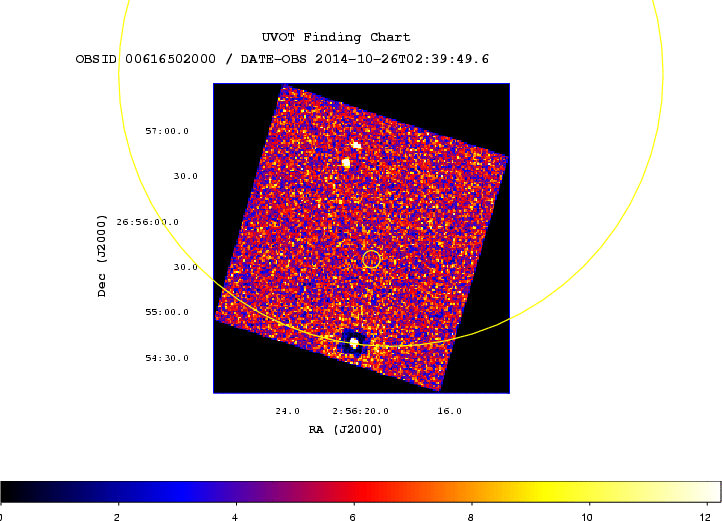
RA(J2000) = 02h 56m 19s Dec(J2000) = +26d 57' 36"with an uncertainty of 3 arcmin (radius, 90% containment, including systematic uncertainty). The real-time TDRSS BAT light curve does not show anything as is typical for an image trigger.
RA(J2000) = +02h 56m 20.14s Dec(J2000) = +26d 55' 34.3"with an uncertainty of 6.1 arcseconds (radius, 90% containment). This location is 122 arcseconds from the BAT onboard position, within the BAT error circle. No event data are yet available to determine the column density using X-ray spectroscopy.
TITLE: GCN/SWIFT NOTICE
NOTICE_DATE: Sun 26 Oct 14 03:37:29 UT
NOTICE_TYPE: Swift-UVOT Source List
TRIGGER_NUM: 616502, Seg_Num: 0
POINT_RA: 44.107d {+02h 56m 26s} (J2000)
POINT_DEC: +26.912d {+26d 54' 43"} (J2000)
POINT_ROLL: 43.984d
IMG_START_DATE: 16956 TJD; 299 DOY; 14/10/26
IMG_START_TIME: 12873.96 SOD {03:34:33.96} UT, 3462.7 [sec] since BAT Trigger Time
FILTER: 10, White
BKG_MEAN: 2.780
N_STARS: 42
X_OFFSET: 373 [pixels]
Y_OFFSET: 395 [pixels]
X_MAX: 1332 [pixels]
Y_MAX: 1354 [pixels]
DET_THRESH: 14
PHOTO_THRESH: 7
SL_URL: sw00616502000msufc3462.fits
SUN_POSTN: 210.44d {+14h 01m 46s} -12.39d {-12d 23' 16"}
SUN_DIST: 160.45 [deg] Sun_angle= 11.1 [hr] (West of Sun)
MOON_POSTN: 238.07d {+15h 52m 16s} -16.78d {-16d 47' 02"}
MOON_DIST: 163.70 [deg]
MOON_ILLUM: 5 [%]
GAL_COORDS: 154.58,-28.17 [deg] galactic lon,lat of the pointing direction
ECL_COORDS: 49.49, 9.69 [deg] ecliptic lon,lat of the pointing direction
COMMENTS: SWIFT-UVOT Source List.
TITLE: GCN/SWIFT NOTICE
NOTICE_DATE: Sun 26 Oct 14 03:37:46 UT
NOTICE_TYPE: Swift-UVOT Processed Source List
TRIGGER_NUM: 616502, Seg_Num: 0
POINT_RA: 44.107d {+02h 56m 26s} (J2000)
POINT_DEC: +26.912d {+26d 54' 43"} (J2000)
POINT_ROLL: 43.984d
IMG_START_DATE: 16956 TJD; 299 DOY; 14/10/26
IMG_START_TIME: 12873.96 SOD {03:34:33.96} UT, 3462.7 [sec] since BAT Trigger Time
FILTER: 10, White
BKG_MEAN: 2.780
N_STARS: 42
X_OFFSET: 373 [pixels]
Y_OFFSET: 395 [pixels]
X_MAX: 1332 [pixels]
Y_MAX: 1354 [pixels]
DET_THRESH: 14
PHOTO_THRESH: 7
SL_URL: sw00616502000msufc3462.fits
SUN_POSTN: 210.44d {+14h 01m 46s} -12.39d {-12d 23' 16"}
SUN_DIST: 160.45 [deg] Sun_angle= 11.1 [hr] (West of Sun)
MOON_POSTN: 238.07d {+15h 52m 16s} -16.78d {-16d 47' 03"}
MOON_DIST: 163.70 [deg]
MOON_ILLUM: 5 [%]
GAL_COORDS: 154.58,-28.17 [deg] galactic lon,lat of the pointing direction
ECL_COORDS: 49.49, 9.69 [deg] ecliptic lon,lat of the pointing direction
COMMENTS: SWIFT-UVOT Processed Source List.
COMMENTS: All 4 attachments are included.
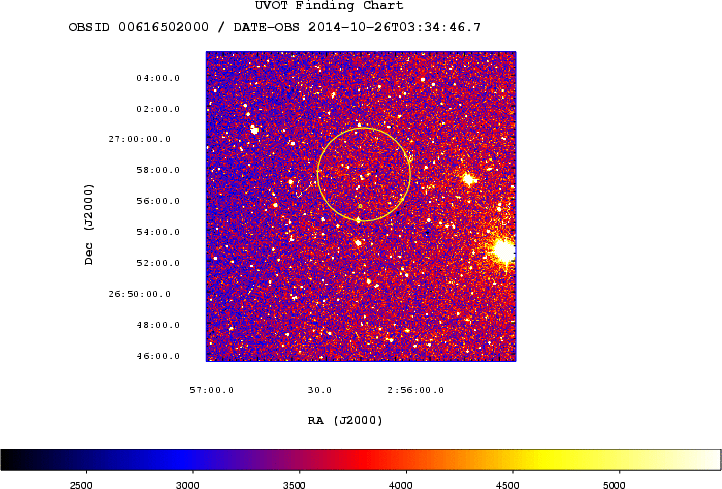
TITLE: GCN/SWIFT NOTICE
NOTICE_DATE: Sun 26 Oct 14 03:38:59 UT
NOTICE_TYPE: Swift-UVOT Image
TRIGGER_NUM: 616502, Seg_Num: 0
POINT_RA: 44.107d {+02h 56m 26s} (J2000)
POINT_DEC: +26.912d {+26d 54' 43"} (J2000)
ROLL: 43.984d
IMG_START_DATE: 16956 TJD; 299 DOY; 14/10/26
IMG_START_TIME: 12873.96 SOD {03:34:33.96} UT, 3462.7 [sec] since BAT Trigger Time
FILTER: 10, White
EXPOSURE_ID: 435987286
X_OFFSET: 692 [pixels]
Y_OFFSET: 714 [pixels]
WIDTH: 160 [pixels]
HEIGHT: 160 [pixels]
X_GRB_POS: 852
Y_GRB_POS: 874
BINNING_INDEX: 1
IM_URL: sw00616502000msuni3475.fits
SUN_POSTN: 210.44d {+14h 01m 46s} -12.39d {-12d 23' 18"}
SUN_DIST: 160.45 [deg] Sun_angle= 11.1 [hr] (West of Sun)
MOON_POSTN: 238.08d {+15h 52m 19s} -16.79d {-16d 47' 09"}
MOON_DIST: 163.69 [deg]
MOON_ILLUM: 5 [%]
GAL_COORDS: 154.58,-28.17 [deg] galactic lon,lat of the pointing direction
ECL_COORDS: 49.49, 9.69 [deg] ecliptic lon,lat of the pointing direction
COMMENTS: SWIFT-UVOT Image.
COMMENTS: The GRB Position came from the Window Position in the Mode Command.
COMMENTS: The image has 2x2 binning (compression).
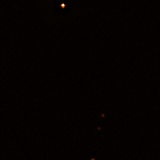
TITLE: GCN/SWIFT NOTICE
NOTICE_DATE: Sun 26 Oct 14 03:39:18 UT
NOTICE_TYPE: Swift-UVOT Processed Image
TRIGGER_NUM: 616502, Seg_Num: 0
POINT_RA: 44.107d {+02h 56m 26s} (J2000)
POINT_DEC: +26.912d {+26d 54' 43"} (J2000)
ROLL: 43.984d
IMG_START_DATE: 16956 TJD; 299 DOY; 14/10/26
IMG_START_TIME: 12873.96 SOD {03:34:33.96} UT, 3462.7 [sec] since BAT Trigger Time
FILTER: 10, White
EXPOSURE_ID: 435987286
X_OFFSET: 692 [pixels]
Y_OFFSET: 714 [pixels]
WIDTH: 160 [pixels]
HEIGHT: 160 [pixels]
X_GRB_POS: 852
Y_GRB_POS: 874
BINNING_INDEX: 1
IM_URL: sw00616502000msuni3475.fits
SUN_POSTN: 210.44d {+14h 01m 47s} -12.39d {-12d 23' 18"}
SUN_DIST: 160.45 [deg] Sun_angle= 11.1 [hr] (West of Sun)
MOON_POSTN: 238.08d {+15h 52m 20s} -16.79d {-16d 47' 10"}
MOON_DIST: 163.69 [deg]
MOON_ILLUM: 5 [%]
GAL_COORDS: 154.58,-28.17 [deg] galactic lon,lat of the pointing direction
ECL_COORDS: 49.49, 9.69 [deg] ecliptic lon,lat of the pointing direction
COMMENTS: SWIFT-UVOT Processed Image.
COMMENTS: The GRB Position came from the Window Position in the Mode Command.
COMMENTS: The image has 2x2 binning (compression).
COMMENTS: All 4 attachments are included.
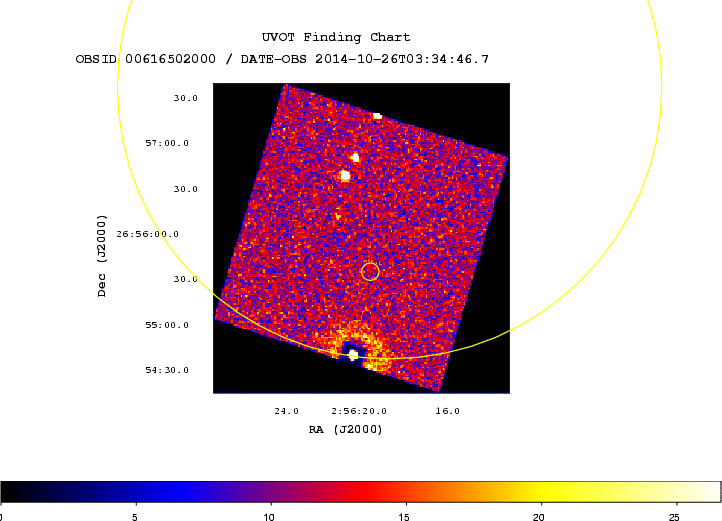
r > 23.50 i > 23.56These magnitudes are in the AB system and are not corrected for Galactic extinction in the direction of the GRB.
r 21.67 +/- 0.08 i 21.52 +/- 0.07We cannot presently determine if this source is fading.
RA (J2000.0) = 02:56:20.16 DEC (J2000.0) = +26:55:41.4with an error of 0".5. This source is also reported by RATIR (Littlejohns et al., GCN #16952). We do not find any variability within errors over the course of our observations. It is likely not associated with the GRB.
g' = 23.2 +/- 0.1 mag r' = 21.8 +/- 0.1 mag i' = 21.5 +/- 0.1 mag z' = 21.2 +/- 0.1 mag J = 20.9 +/- 0.3 mag H = 20.5 +/- 0.3 mag K > 18.7 magGiven magnitudes are calibrated against GROND zeropoints (g'r'i'z') and 2MASS field stars (JHK) and are not corrected for the expected Galactic foreground extinction corresponding to a reddening of E_(B-V)=0.18 mag in the direction of the burst (Schlegel et al. 1998).
RA (J2000): 02h 56m 20.24s Dec (J2000): +26d 55' 40.9"with an uncertainty of 1.9 arcsec (radius, 90% confidence).
RA(J2000) = 02h 56m 11.8s Dec(J2000) = +26d 55' 31.7"with an uncertainty of 1.9 arcmin, (radius, sys+stat, 90% containment). The partial coding was 88%.
Total column: 2.8 (+1.2, -1.0) x 10^21 cm^-2 Galactic foreground: 1.6 x 10^21 cm^-2 Excess significance: 2.0 sigma Photon index: 1.92 (+0.28, -0.26)If the light curve continues to decay with a power-law decay index of 0.35, the count rate at T+24 hours will be 0.023 count s^-1, corresponding to an observed (unabsorbed) 0.3-10 keV flux of 8.9 x 10^-13 (1.2 x 10^-12) erg cm^-2 s^-1.
r 21.74 +/- 0.07 i 21.54 +/- 0.06 z > 20.5These magnitudes are in the AB system and are not corrected for Galactic extinction in the direction of the GRB. Further observations are planned.
Filter T_start(s) T_stop(s) Exp(s) Mag white (fc) 165 208 83 >19.98 white 3462 5667 688 >21.45 v 144 5962 290 >19.34 b 3826 5463 393 >20.48 u 3621 5258 393 >20.15 uvw1 4852 5052 196 >19.61 uvm2 4647 4847 196 >19.58 uvw2 4237 5873 393 >20.26The magnitudes in the table are not corrected for the Galactic extinction due to the substantial reddening of E(B-V) = 0.19 in the direction of the burst (Schlegel et al. 1998).
r 22.94 +/- 0.16 i 23.16 +/- 0.22 z > 20.1These magnitudes are in the AB system and are not corrected for Galactic extinction in the direction of the GRB. The source appears to have faded roughly as t^(-0.5) since our last epoch (GCN 16962).
==================================
tmid scope expos fil limit
==================================
10m PROMPT3 4x80s B >19.9
20m PROMPT1 4x160s V >20.4
19m PROMPT4 3x160s R >19.8
17m PROMPT5 4x80s I >19.9
4X160s
17m PROMPT8 12x80s I >20.0
63m Yerkes 1x80s g' >21.2
2x160s
60m Yerkes 2x80s r' >20.9
1x160s
66m Yerkes 1x80s i' >20.5
1x160s
==================================
BVRI magnitudes are in the Vega System, and g'r'i' magnitudes are in the
AB system, calibrated to 4 APASS stars in the field. Magnitudes have
not been corrected for line-of-sight Milky Way dust extinction, with
expected E(B-V)=0.16 (Schlafly & Finkbeiner 2011).
r > 23.54 i > 23.31 z > 19.82These magnitudes are in the AB system and are not corrected for Galactic extinction in the direction of the GRB. In comparison to previous epochs of RATIR observations (Butler, et al., GCN 16965; Littlejohns, et al., GCN 16962), the GRB has continued to fade. The r band upper limit indicates a power-law decay between this and the previous epoch of RATIR observations with a minimum approximate index of t^(-0.9). This is steeper than that reported in Butler, et al. (GCN 16965).
Mean epoch | Freq. (GHz) | Flux (uJy) | map rms (uJy) ------------------------------ 6.5 hr | 21.8 | 11 | 11 ------------------------------ 1.1 d | 21.8 | 43 | 11 ------------------------------ 4.3 d | 21.8 | 31 | 8 ------------------------------ 6.0 d | 6.2 | 91 | 7 ------------------------------
Date UT start, t-t0 Filter Exp. OT OT_err
(mid, days) (s)
2014-10-26 18:25:48 0.7020 R 53*120 21.88 0.18
The photometry is based on USNO-B1.0 stars
RA DEC R 044,065509 +26,958050 18.71 044,051792 +26,894737 18.59 044,049131 +26,929059 17.48